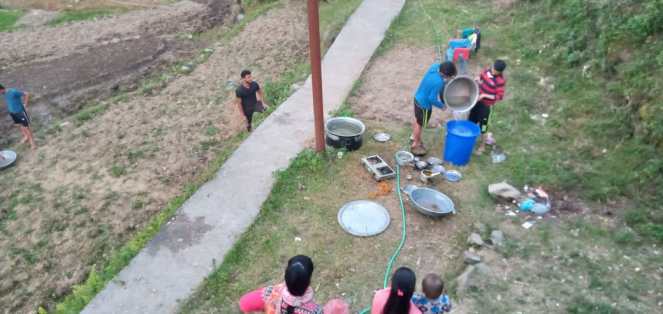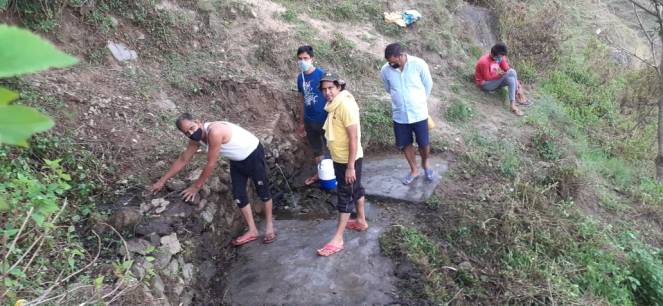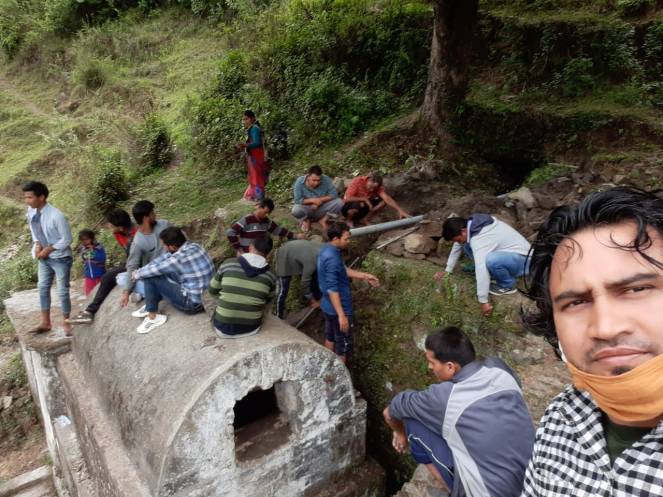A small village in Uttarakhand is setting a big example by reviving traditional water sources
Many migrants have returned to the state due to the lockdown. Now, they have taken up the responsibility of reviving the traditional freshwater sources and springs in the region

Traditional water sources have been the ‘water lifeline’ for most of the villages in the hilly areas of Uttarakhand. Known as panyar, naula, chhoi, dhara, these freshwater sources and springs have been serving the rural population with potable and other domestic water requirements since time immemorial.
Sadly, with changing time, lifestyle, and the introduction of tap water facilities, these water sources and structures have been facing the negligence of the users, and the apathy of the government. These time-proven water sources can still serve people if restored and taken proper care by the village communities. The story of Pokhri village in the Pauri Garhwal district of Uttarakhand is a step in the right direction.
The hilly districts in the state are witnessing a reverse migration — particularly of the youngster who had migrated to different parts of the country to make a living — in the wake of the Covid-19 pandemic and the subsequent lockdown. As per reports, over 1.5 lakh migrated natives have returned to the state out of more than two lakh who had applied.
Pokhari is a small village located in Chauthan Patti, a region comprising 72 villages in the Thailisain block. The village has a population of around 300, and, so far, about 46 people have returned to their homes from various parts of the country.
Most of the around 1,500 returnees to the area, presently quarantined at primary schools, have voluntarily engaged themselves in constructive activities. The youths in quarantine centres in Pokhari have joined the trend and started cleaning water bodies, and taken up plantation work in and around the school premises.
In the last week of May 2020, the pipeline-based water supply of the village got disrupted causing a great inconvenience to all. The villagers made all the possible efforts, even pleaded to local administration and the Upnal (water) department. However, the problem could not be resolved, and finally, the Upnal staff told villagers that the problem cannot be resolved unless a new separate pipeline is laid for the village which would take some time.

Meanwhile, the crisis offered an opportunity to the villagers to look for their natural water sources. Those who were in the quarantine centres and who were out of isolation, joined hand with the villagers and started an initiative to restore the two potable water springs, a water structure to feed cattle and an ancient tank structure.
“The springs were surrounded with bushes, due which the water supply had fallen. So, first, we removed the weeds and plugged the leakage to make it accessible and to increase the water supply,” said Hemant Kala, who used to work as a driver in Delhi and is now actively involved in the restoration work.


The other group of village youths then saw another small tank which was built around two decades back to feed the cattle. “The chari (tank) was built to collect potable water for the livestock, but it was full of muck and silt serving no purpose. A thick layer of the invasive weed pagal jhad (the mad weed officially known as Ram Bansa or Mexican weed) had grown around it. The village youth first cleaned the tank and uprooted the weeds to make the tank usable. Now, we are trying to revive the recharge source of the tank to fill it,” shared Vivakanand Kala, another youth who was working in the private sector in Delhi, and has returned to the village due to the lockdown.


The village youth had also formed a local committee — Pokhari Yuva Sangthan – a few years back. Vivekanand, who also heads the committee, said the water crisis has inspired them to take up the restoration work of water sources and structures on a priority basis.
The villagers have not stopped at this and turned to one more defunct panyara (water spring). “The structure of the panyara had broken down. There was mud all around making it out of use. We first levelled the spot and then built the stone structure to channelise the water and now it’s open for all to use,” said Rajesh Kandari, who, with some local volunteers, rebuilt the water structure. He works in Germany, but was stuck in the country due to the lockdown.

After repairing it, the team, that also included young kids, smiled and quenched their thirst with water from the same water source. The restored panyara is close to the common path and they say even people passing by can find drinking water there.
“The effort is fully self-motivated and self-financed. We have been given no government aid for the work,” said Vinod Kumar, the village headman who fully supports the initiative, and even lends a helping hand to the villagers. As per him, the youths are voluntarily working on the restoration of village water structures, thus making great effort to find local solutions to the ongoing water crisis.
But he has some concerns and questions too. “With great emphasis on toilet-building and cleanliness, most of villagers have placed water tanks on rooftops which need to be filled for flushing and bathing purposes. This consumes major share of water supply and it is now hard to live without these facilities”.
Though he is happy with the effort, but feels that unlike the past, now it is very difficult to meet all the water requirement through local sources.
Undeterred with the concerns, the village youth committee then took to their oldest water structures known as diggi panyara. Diggi is commonly referred to the tanks built to supply potable water when the state was the part of the undivided Uttar Pradesh.

“Disconnected with the water source, the tank had dried up, so we cleaned it, tapped the original water source again by laying a six-meter long pipe and now it is getting adequate water supply,” said a joyous Surendra Bhandari, who works in Delhi with a leading newspaper as a web designer, and is also part of the village committee.
According to him, natural water sources are a boon for the hilly people and cannot be compared with the pipe water in taste and quality. “They serve cold water in summer and lukewarm in winter. The senior citizens still prefer the panyara water over the tap supply water,” said Surendra.
He also stated that during their quarantine period, they faced water scarcity for eight days and the ongoing crisis helped them realise the significance of natural water sources. Hence the team is determined to restore all of them.
The team feels that in the process of development, the traditional water sources have been neglected, and they deserve better attention and awareness, particularly among village communities.
To resolve the pipeline supply issue, the villagers on June 4, 2020 convened a meeting with the concerned officials. “Our village is supplied water with a single pipeline with neighbouring uphill village. With the increase in demand, a single pipeline cannot meet the requirement,” said Manoj Kandari, a village youth returned to village from Dehradun where he was preparing for job of a lecturer.
“But now, we would not let our traditional water sources die for the want of our attention,” said Manoj, who is currently serving his quarantine period and is keenly waiting to join hands with other youths.
Amid uncertainties over the lockdown and jobs, young people have taken to farming activities. “It’s paddy season, which needs irrigation. So, the youth have started cleaning and repairing their kools (smaller traditional irrigation channels) and smaller canals. Again, all the collective efforts are purely on the shramdaan basis where the villagers and the committee are sharing the cost of the pipes, cements etc,” said an enthusiastic Hemant Kala.

The initiative by the youths of Pokhari shows that with little efforts and work, local water sources can be restored. We wish them all the success and hope youths in the other hilly areas would feel motivated to start work for the restoration of their natural water sources and traditional water structures.
This article has been sourced from SANDRP. You can read the original article here.

